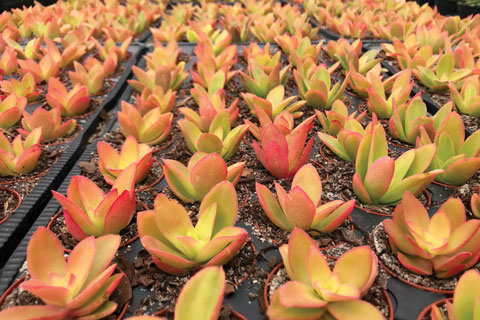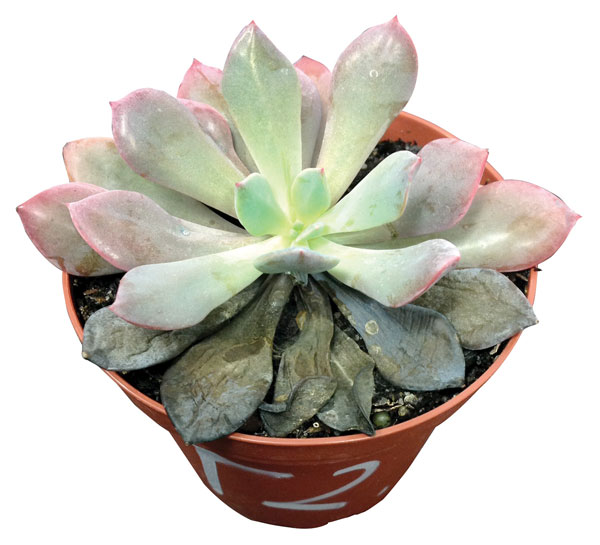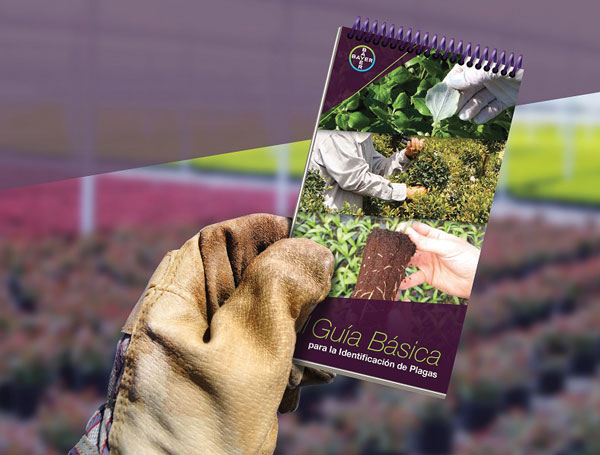9/1/2020
Succulents Have Problems, Too
Dr. Aaron Palmateer

 Succulents are plants with thick, fleshy parts that are used to store water during dry seasons in their natural habitats. “Succulent” is actually a descriptive word for the plant rather than the genus and species.
Succulents are plants with thick, fleshy parts that are used to store water during dry seasons in their natural habitats. “Succulent” is actually a descriptive word for the plant rather than the genus and species.
The popularity of succulents is mostly due to their striking and unusual appearance, as well as their ability to thrive with minimal care. The majority of succulent plants are slow-growing and some produce stunning flowers. Most thrive under dry conditions with well-drained soil and require little attention.
Pictured: Succulents have grown in popularity for their distinctive look and low-maintenance needs.
While most people think of cacti when they hear “succulent,” not all succulents are cacti. Some popular examples include adenium, aloe, dracaena (formerly sansevieria), echeveria, kalanchoe, sedum, senecio and sempervivum.
Due to their popularity as a house or office plant, more growers are adding succulents to their plant inventory. Their unusual appearance sometimes makes it difficult to recognize a healthy succulent from one that’s stressed and possibly infected with disease. When diagnosing the status of any plant, it’s critical for pathologists and growers alike to understand the biology, and it’s especially important when working with uncommon or unusual species.
Just like with any plant, succulents aren’t immune to disorders and we learn more as we grow more succulents. Many succulent plants originated in arid climates and have evolved to thrive under dry conditions, so growing them in humid environments with plentiful water is likely to create issues. Some of these issues may include physiological changes induced by environmental conditions such as edema. Edema occurs when plants take up more water than the leaves can transpire, which causes cells in the leaves to retain water and appear swollen. Favorable environmental conditions for edema include fluctuation in temperature from warm to cool, high humidity and cloudy days.
Most succulents seem to be susceptible to edema and I’ve found it to be fairly common on aloe, echeveria, sansevieria and sedum in Florida. One of the more striking and sometimes appealing physiological changes in succulents is their response to different light conditions by changing in color. Some examples include aloe, crassula (jade), graptopetalum, graptoveria and echeveria where the leaves change from green to a rosy red color with increased light.
 Most physiological changes in the plant aren’t detrimental and plants will likely recover. However, more often than not, plant pathogens—including even some of the less aggressive fungi and bacteria—will take advantage of a stressful situation and infect compromised tissue and make matters worse by causing disease.
Most physiological changes in the plant aren’t detrimental and plants will likely recover. However, more often than not, plant pathogens—including even some of the less aggressive fungi and bacteria—will take advantage of a stressful situation and infect compromised tissue and make matters worse by causing disease.
Pictured: Pythium myriotylum will rot the roots, stems and lower leaves of echeveria.
Some of the more common leaf spot pathogens reported to cause diseases of succulents include Alternaria, Bipolaris/Helminthosporium, Botrytis, Cladosporium, Colletotrichum and Cercospora. Leaf spot symptoms caused by Alternaria, Bipolaris/Helminthosporium, Colletotrichum and Cercospora can be similar, initially appearing as small (2 to 4 mm), circular, dark green, water-soaked lesions on the upper surface of leaves. The lesions gradually become larger and turn brown to dark brown or black. Depending on the host, sometimes these spots may have a yellow or purplish red margin, which is especially common with leaf spots caused by Cercospora.
Botrytis is most often associated with dead or dying tissue (i.e., senescent flowers or older leaves), but can easily spread to healthy tissue causing water-soaked spots that become covered in an abundance of grayish white spores of the pathogen.
Cladosporium species are often isolated from raised, pimple-like spots on the upper leaf surface, with a common example being Cladosporium tenuissimum causing a leaf spot on echeveria.
Root, stem and crown rot diseases can be problematic, especially on succulents growing in cooler temperatures with high humidity. Fusarium, Pythium, Phytophthora and Rhizoctonia can all start as root rots and then progress upwards to stem and crown tissue with wet and humid conditions. A good example can be seen with Pythium myriotylum, which rots the roots, stem and lower leaves of echeveria.
Bipolaris cactivora is often associated with stem rot of cacti, with documented cases and descriptions of disease on cereus and hylocereus. All of these diseases are destructive and likely fatal when left untreated with fungicides.
Disease prevention is best achieved by following strict sanitation protocols to minimize the introduction of plant pathogens, but preventative fungicide applications are a must for optimum plant quality. Broadform fungicide has consistently demonstrated effective control of Botrytis and other diseases reported on succulents. Dual modes of action in Broadform include fluopyram (SDHI) and trifloxystrobin (QOI), which provide broad spectrum and long-lasting disease control.
Fungicides are one of the most important tools for effective disease management and it’s critical to follow manufacturer recommendations for proper rates and application intervals. The proper use of fungicides and recognizing the importance of rotating FRAC groups will ensure long-term success and future availability of fungicides for disease management.
With more succulents produced in greenhouses and nurseries across the U.S., we’ll likely see increased incidences of existing diseases, as well as the emergence of new ones. There are reports of downy mildews, powdery mildews and rust diseases affecting various succulents outside the continental U.S., but the risk of introduction of these diseases will likely increase with greater numbers of plants in commercial production.
For more information on Broadform and other solutions from Bayer for managing pests in greenhouse and nursery production, visit es.bayer.us/ornamentals.
Dr. Aaron Palmateer is a Senior Technical Support Representative, Ornamentals for Bayer.
A New Pest ID Tool for Spanish-Speaking Workers

Greenhouses and nurseries are culturally diverse and English may not be everyone’s first language. While there are bilingual and bicultural staff in place in many nurseries and greenhouses, there are varying levels of literacy among workers and there’s a need to be able to communicate in a more concise way about pests and the solutions to manage them.
That’s why Bayer has developed a pest guide specifically for Spanish speakers. This user-friendly guide is easy to follow and includes numerous pictures to help Spanish speakers not only identify pests, but also understand how to leverage Bayer solutions to control those pests.
The pest identification guide is available to order now. Visit www.es.bayer.us/spanish-pest-identification-guide to learn more. GT